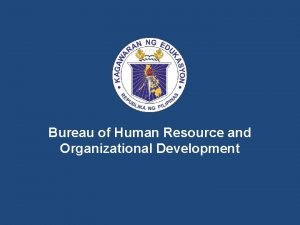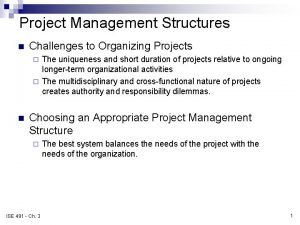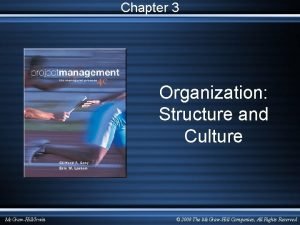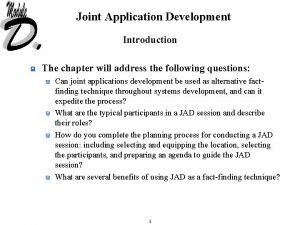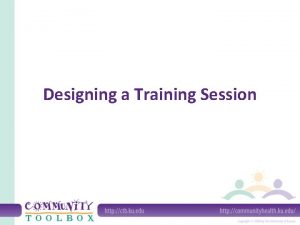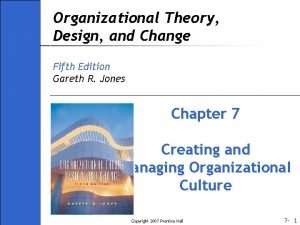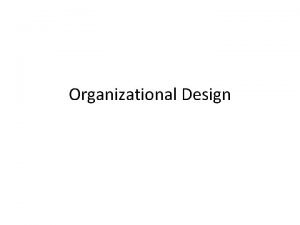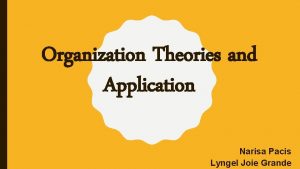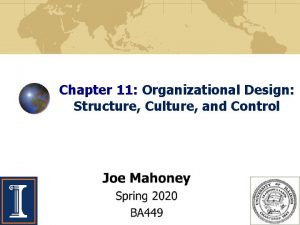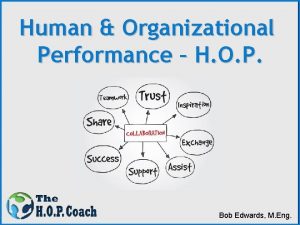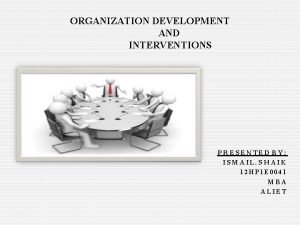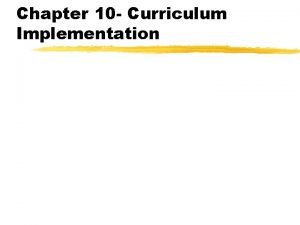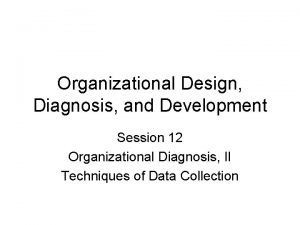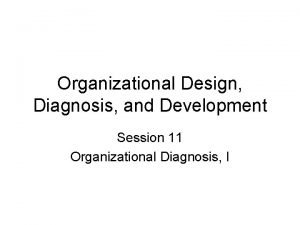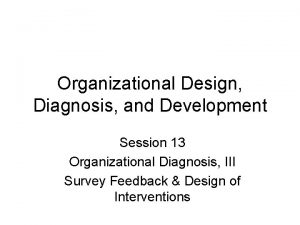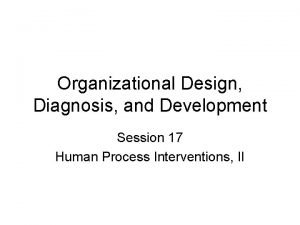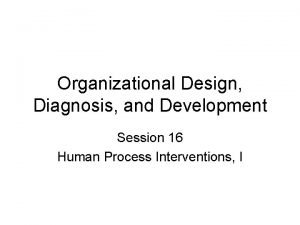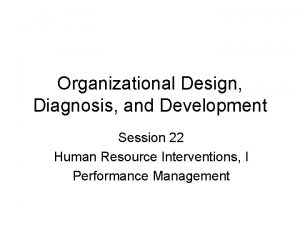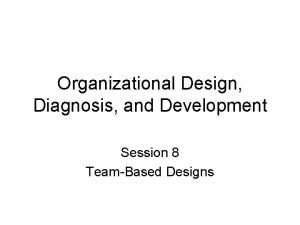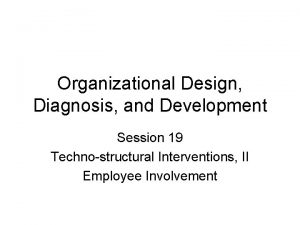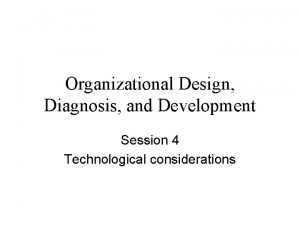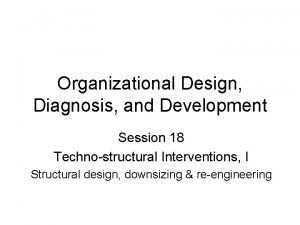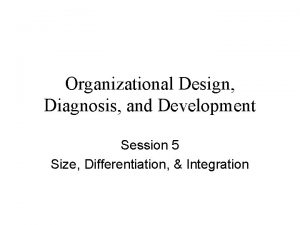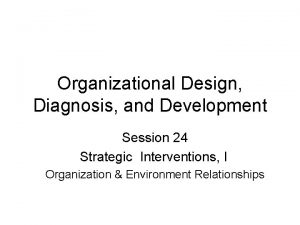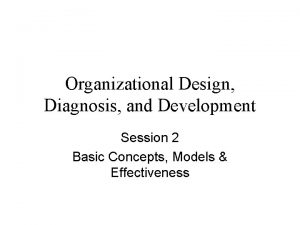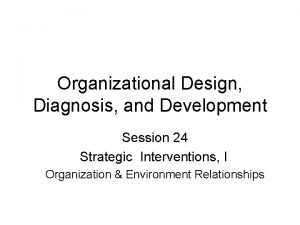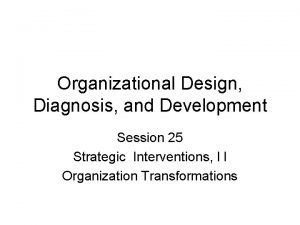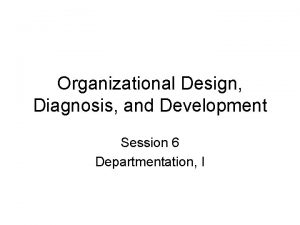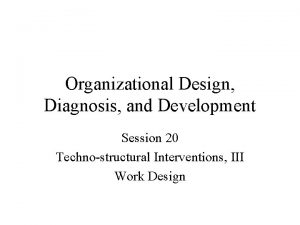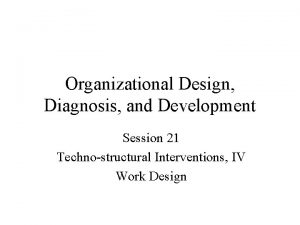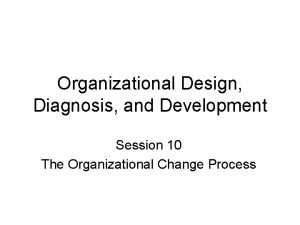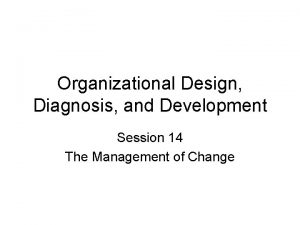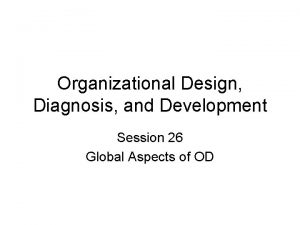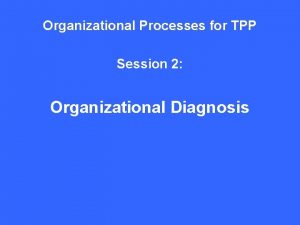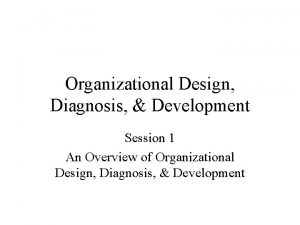Organizational Design Diagnosis and Development Session 23 Human



























- Slides: 27

Organizational Design, Diagnosis, and Development Session 23 Human Resource Interventions, II Developing & Assisting Members

Objectives • To understand what is involved in career planning, the changing nature of careers, and stages of career progression • To recognize issues faced by employees in managing their careers stages • To describe issues faced by organizations in career management • To understand the strategic implications of managing diversity • Discuss sources of workplace stress, EAPs and wellness programs

The Importance of Careers • For organizations: Helps align staffing with strategy • For employees: A source of identification and a factor in quality of life

Career Planning • Employee responsibility: – Self-assessment, – Identify and analyze career options; – Decide and develop career objectives and needs; – Communicate career preferences to your manager; – Map out a plan with your manager.

Career Planning • Management responsibilities: – Encourage career planning process, – Assess realism of employee’s plans, – Provide information to employee about career planning resources, and career development opportunities such as job openings, training programs, and rotation assignments.

Changing Nature of Careers • The employment contract: Employees as free agents – Career competencies – Self-management • New career paths: More webbed than straight

Importance of Career Planning to Organizations • Effective utilization of human resources – Align staffing requirements to strategy – Develop promotable employees • Affirmative action and EEO – Assists in meeting goals – Assists in diversity management

Exploration Stage • Task Needs: – Experiencing varied job tasks – Self assessment – Job choice • Social-emotional needs – Occupational selfimage – Settling down

Establishment Stage • Task needs – – Learn the ropes Get challenging jobs Increase competence Be innovative • Emotional needs – Deal with competition, failure, conflicts – Develop autonomy

Maintenance Stage • Task needs – Technical updating – Coaching skills – Continue to rotate into new areas – Develop broad view of career • Social-emotional needs – Express mid-life feelings – Rethink work, family

Late Career Stage • Task needs – Remain productive – Plan for retirement – Shift role from power to guidance – Identify successors – Develop outside interests • Social emotional needs – Re-envision work – Develop outside identity

Career Planning for Men & Women • • Some research findings The glass ceiling The mommy track The dual career couple track

Some Research Findings • Men benefit more than woman from training • Men benefit more than women from being married and having children • Women benefit more than men from coaching and encouragement • Women have fewer developmental opportunities than do men

Glass Ceilings & Mommy Tracks • Glass ceiling: A barrier ( usually not an obvious one) that prevents women from reaching top management. • Mommy tracks: Career paths which give more time flexibility to allow women to fulfill family commitments

Dual Career Couples • The Family Friendly Workplace – flexible work arrangements – child care arrangement – support for transfers and relocations – managers who understand dual career couples

Need to Manage Diversity • Current work force is diverse – race & ethnicity – gender – age – disabilities

Diversity as an Asset • Salesforce • Problem solving and creativity • From manufacturing to service economy

Challenges of Diversity • Universal Vs relative management practices • Resistance to change • Group cohesiveness & conflict • Competition • Performance • Backlash

Top Management Commitment • • Training programs Support groups Mentoring programs Accommodating family needs – Alternative career paths – On-site child care – Alternative work arrangements

Top Management Accountability • Monitoring work place fairness • Using reward systems

The Process of Stress Physiological symptoms Organizational Factors Experienced Stress Individual Factors Psychological Symptoms Behavioral Symptoms

Stress Factors • Organizational • Demanding Jobs • Competing demands • Role ambiguity • Job responsibility • Isolation • Unpleasant • Individual • Stressful life events • Daily stress • Personality • Perception

Consequences of Stress • Physiological Symptoms – Headaches, High blood pressure, Heart disease • Psychological Symptoms – Anxiety, Depression, Burnout, Callousness • Behavioral Symptoms – Productivity loss, Withdrawal

Managing Stress • Personal approaches – Lifestyle, Physiological, Cognitive • Organizational approaches – Job redesign – Social support – Family friendly policies

EAPs • EAPs: Programs which provide counseling and service to troubled employees – Managers need to identify behavior which signals trouble – Company needs to communicate program & policy • Evaluation: Seem to be cost effective

Wellness Programs • Focus is on prevention • Educate employees about health risks • Introduce programs to reduce health risks and modify risky behavior • Help employees maintain new behaviors • Evaluate

Backwards & Forwards • Summing up: Today’s session explored careers and special issues in career planning for affirmative action and family friendly policies along with diversity issues and employee wellness • Looking ahead: Next time we being an examination of strategic interventions with organizations and environments
 Human resource development plan for deped
Human resource development plan for deped Nursing process definition
Nursing process definition Medical diagnosis and nursing diagnosis difference
Medical diagnosis and nursing diagnosis difference Types of nursing diagnosis
Types of nursing diagnosis Nursing process and critical thinking
Nursing process and critical thinking Perbedaan diagnosis gizi dan diagnosis medis
Perbedaan diagnosis gizi dan diagnosis medis Chapter 8 human needs and human development
Chapter 8 human needs and human development Chapter 8 human needs and human development
Chapter 8 human needs and human development Organizational culture diagnosis worksheet
Organizational culture diagnosis worksheet Chapter 3 organization structure and culture
Chapter 3 organization structure and culture Human development index definition ap human geography
Human development index definition ap human geography Joint application development
Joint application development Training session design
Training session design Microsoft technology centre
Microsoft technology centre Chapter 5 diversity and human needs and development
Chapter 5 diversity and human needs and development Vce hhd study design
Vce hhd study design Organizational theory design and change
Organizational theory design and change Organizational structure and design
Organizational structure and design Simple organizational design strength and weaknesses
Simple organizational design strength and weaknesses Technical feasibility example
Technical feasibility example Political feasibility
Political feasibility Organizational design: structure, culture, and control
Organizational design: structure, culture, and control What is organization
What is organization Bobs guide to operational learning
Bobs guide to operational learning Organizational development interventions examples
Organizational development interventions examples Comprehensive intervention
Comprehensive intervention Development change adalah
Development change adalah Organizational development model in curriculum
Organizational development model in curriculum
